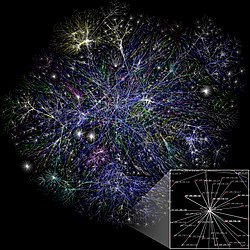
Back Bezškálová síť Czech Skalenfreies Netz German Red libre de escala Spanish شبکه بیمقیاس Persian Skaalautumaton verkko Finnish Réseau invariant d'échelle French Skálafüggetlen hálózat Hungarian Rete a invarianza di scala Italian 척도 없는 네트워크 Korean Безразмерна мрежа Macedonian

| Part of a series on | ||||
| Network science | ||||
|---|---|---|---|---|
| Network types | ||||
| Graphs | ||||
|
||||
| Models | ||||
|
||||
| ||||
A scale-free network is a network whose degree distribution follows a power law, at least asymptotically. That is, the fraction P(k) of nodes in the network having k connections to other nodes goes for large values of k as
where is a parameter whose value is typically in the range (wherein the second moment (scale parameter) of is infinite but the first moment is finite), although occasionally it may lie outside these bounds.[1][2] The name "scale-free" could be explained by the fact that some moments of the degree distribution are not defined, so that the network does not have a characteristic scale or "size".
Preferential attachment and the fitness model have been proposed as mechanisms to explain the power law degree distributions in real networks. Alternative models such as super-linear preferential attachment and second-neighbour preferential attachment may appear to generate transient scale-free networks, but the degree distribution deviates from a power law as networks become very large.[3][4]
- ^ Onnela, J.-P.; Saramaki, J.; Hyvonen, J.; Szabo, G.; Lazer, D.; Kaski, K.; Kertesz, J.; Barabasi, A. -L. (2007). "Structure and tie strengths in mobile communication networks". Proceedings of the National Academy of Sciences. 104 (18): 7332–7336. arXiv:physics/0610104. Bibcode:2007PNAS..104.7332O. doi:10.1073/pnas.0610245104. PMC 1863470. PMID 17456605.
- ^ Choromański, K.; Matuszak, M.; MiȩKisz, J. (2013). "Scale-Free Graph with Preferential Attachment and Evolving Internal Vertex Structure". Journal of Statistical Physics. 151 (6): 1175–1183. Bibcode:2013JSP...151.1175C. doi:10.1007/s10955-013-0749-1.
- ^ Krapivsky, Paul; Krioukov, Dmitri (21 August 2008). "Scale-free networks as preasymptotic regimes of superlinear preferential attachment". Physical Review E. 78 (2): 026114. arXiv:0804.1366. Bibcode:2008PhRvE..78b6114K. doi:10.1103/PhysRevE.78.026114. PMID 18850904. S2CID 14292535.
- ^ Falkenberg, Max; Lee, Jong-Hyeok; Amano, Shun-ichi; Ogawa, Ken-ichiro; Yano, Kazuo; Miyake, Yoshihiro; Evans, Tim S.; Christensen, Kim (18 June 2020). "Identifying time dependence in network growth". Physical Review Research. 2 (2): 023352. arXiv:2001.09118. Bibcode:2020PhRvR...2b3352F. doi:10.1103/PhysRevResearch.2.023352.
© MMXXIII Rich X Search. We shall prevail. All rights reserved. Rich X Search




